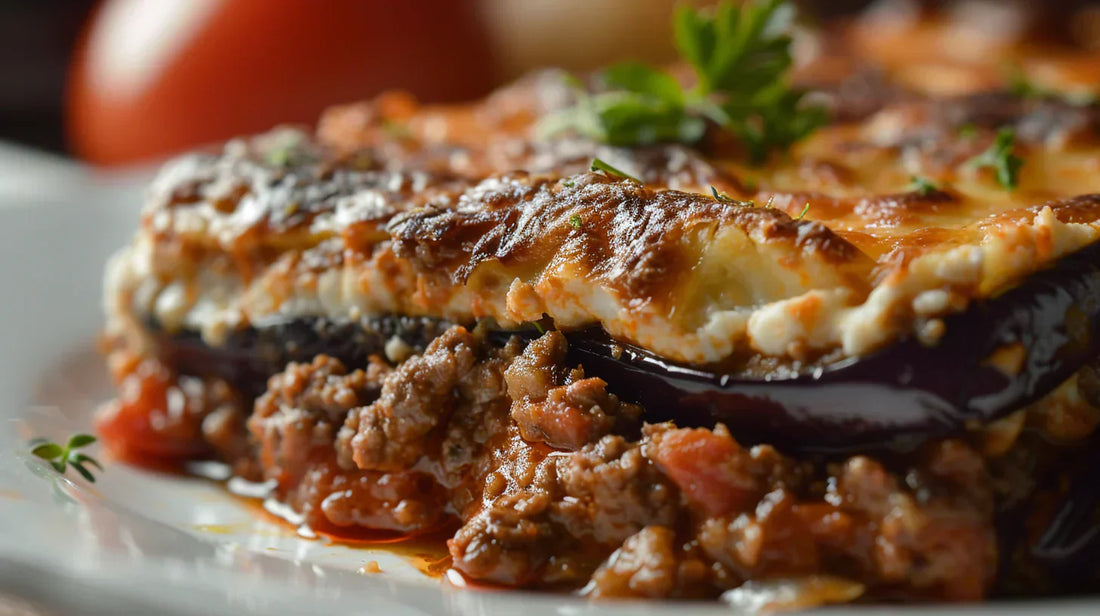Introduction to Moussaka
Moussaka is an iconic Greek dish, renowned for its savory layers of eggplant, minced meat, and béchamel sauce. This Mediterranean specialty is distinguished by its rich flavors and gratinated texture, offering a comforting and delicious dining experience. Although commonly associated with Greece, moussaka has variations throughout the Mediterranean, with each region adding its own twist to this classic.
Origins and History
Moussaka, as we know it today, has its roots in Ottoman cuisines, where various forms of layered dishes were popular. However, the modern version with eggplant and béchamel sauce was popularized in Greece in the early 20th century by chef Nicolas Tselementes. He had a significant influence on modern Greek cuisine and is often credited with introducing Western cooking techniques and styles to Greece, including the use of béchamel sauce in moussaka.
Regional Varieties
Although the Greek version of moussaka is the most well-known internationally, there are many regional variations around the world. In Turkey, for example, moussaka is often prepared without béchamel sauce and may include potatoes as well as eggplant. In the Balkans, a version may include zucchini instead of eggplant. Each regional variation of moussaka reflects local tastes and ingredients, making it a truly versatile and adaptable dish.
Traditional Greek Moussaka
This recipe focuses on the traditional Greek version of moussaka, with layers of grilled eggplant, rich meat sauce flavored with cinnamon and oregano, and topped with a creamy béchamel sauce. It's a heartwarming dish that's perfect for a meal with family or friends. Follow our step-by-step guide to recreate this Greek specialty at home and let yourself be transported by its authentic Mediterranean flavors.
| Summary | |
|---|---|
| 🔍 Information | Details |
| ⏱️ Preparation time | 40 minutes (20 min to prepare the vegetables + 20 min to prepare the potatoes) |
| 🍳 Cooking time | 45 minutes |
| ⏲️ Total time | 1 hour 25 minutes |
| 🔧 Difficulty level | AVERAGE |
| 🍽️ Servings | 6-8 servings |
| 🔥 Calories (approximate) | 450 per serving |
| Ingredients |
|---|
|
| Instructions |
|---|
|
Q & A on Greek Moussaka
Q: Can moussaka be prepared in advance?
A: Yes, moussaka lends itself well to making ahead of time. You can assemble the dish and refrigerate it for up to 24 hours before baking. Be sure to cover it with plastic wrap or a suitable lid to prevent it from drying out. Remove it from the refrigerator about an hour before baking to allow the moussaka to come to room temperature, which will ensure even cooking.
Q: Can moussaka be frozen?
A: Absolutely, moussaka freezes very well. For best results, cook the moussaka as directed, then let it cool completely. You can then cut it into portions and freeze them individually, or freeze the whole dish. To reheat, defrost the moussaka in the refrigerator overnight, then reheat it in the oven until piping hot.
Q: What side dish should I serve with moussaka?
A: To accompany moussaka, a green salad or a traditional Greek salad with tomatoes, cucumbers, olives, red onions, and feta cheese is ideal. The crunch and freshness of the salad perfectly complement the rich, deep flavors of the moussaka. Warm pita bread or fresh bread can also accompany the dish to soak up the savory sauce.
Q: Can other types of meat be used for moussaka?
A: While lamb and beef are the traditional choices for moussaka, you can experiment with other types of ground meat according to your preferences. Veal or a mixture of pork and beef can offer interesting variations on the classic theme. Be sure to adjust the seasonings depending on the type of meat chosen to maintain a balanced flavor.
Q: Is there a vegetarian version of moussaka?
A: Yes, it's perfectly possible to make a vegetarian version of moussaka by replacing the ground meat with a mixture of roasted vegetables like mushrooms, peppers, and zucchini. You can also add cooked lentils to add texture and protein. Be sure to adjust the seasonings to complement the vegetables you're using.
Countries where Moussaka is most popular
| Country | Popularity |
|---|---|
| Greece | Very popular |
| Türkiye | Popular |
| Cyprus | Popular |
| Balkans | Moderately popular |
| Egypt | Popular |
| Lebanon | Moderately popular |


6 comments
Il n’y a PAS de pommes de terre dans la moussaka grecque !!!
Bonjour,peut on mélanger deux viandes? Merci
Dans la recette vous dites aubergines et pommes de terre puis la sauce à la viande. Sur la photo qui est magnifique, on voit la viande en premier et ensuite les aubergines. Avez-vous un avis la dessus. Qu’est-ce-qui est mieux ?? Je teste la recette ce week-end j’espère réussir. Un grand merci pour votre partage. Patricia
Pour ma part, j’ai ajouté à mes couches d aubergines et de pommes de terre, des poivrons rôtis (peau enlevée) et de l origan frais à la fin de la cuisson de la sauce. Super!
Recette intéressante. Pour ma part Je vais remplacer la viande de bœuf / agneau par du confit de canard…